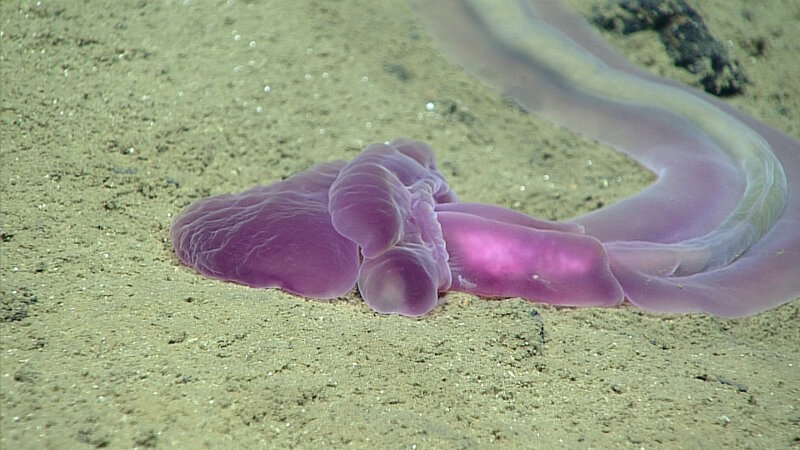
Acorn worms were just one of the many types of strange fauna observed at Twin Peaks. Image courtesy of the NOAA Office of Ocean Exploration and Research, 2016 Deepwater Exploration of the Marianas. Download larger version (jpg, 835 KB).

Acorn worms were just one of the many types of strange fauna observed at Twin Peaks. Image courtesy of the NOAA Office of Ocean Exploration and Research, 2016 Deepwater Exploration of the Marianas. Download larger version (jpg, 835 KB).
Mud Monsters
During the dive on a site dubbed 'Twin Peaks,' scientists observed fauna ranging from swimming sea cucumbers, carnivorous sponges, and acorn worms to several long-legged isopods, hermit crabs with commensal anemones, pregnant mysid shrimp, many stalked sponges, several deep-sea lizard fish (Bathysaurus cf molis), and a shrimp with unique adaptations that was unknown to our science team. Video courtesy of the NOAA Office of Ocean Exploration and Research, 2016 Deepwater Exploration of the Marianas. Download (mp4, 87.6 MB)
Dive 13 was conducted on a potential mud volcano site, dubbed Twin Peaks. Remotely operated vehicle Deep Discoverer (D2) landed on a nearly featureless sedimented bottom made of very small, pale-brown particles at a depth of 4,829 meters. At the start of the dive, we saw slabby exposures of rock a few centimeters to tens of centimeters above the sediment that were aligned in linear rows parallel to one another. The rocks were mantled with a black (likely manganese-oxide) coating, but at the base of some of the slabs there was an exposure of a pale-tan to yellow-orange surface with a rough, rubbly texture. The seafloor throughout most of the dive remained thickly sedimented. Based on the prevalence of the small outcroppings of sedimentary rocks throughout the dive, it is unlikely that this site is, as we had hoped, a serpentinite mud volcano. Rather, it appears to be a fault block of forearc sedimentary sequences. Fauna observed during the dive included swimming sea cucumbers, carnivorous sponges, acorn worms, several long-legged isopods, hermit crabs with commensal anemones, pregnant mysid shrimp, many stalked sponges, several deep-sea lizard fish (Bathysaurus cf molis), and a shrimp with unique adaptations that was unknown to our science team.